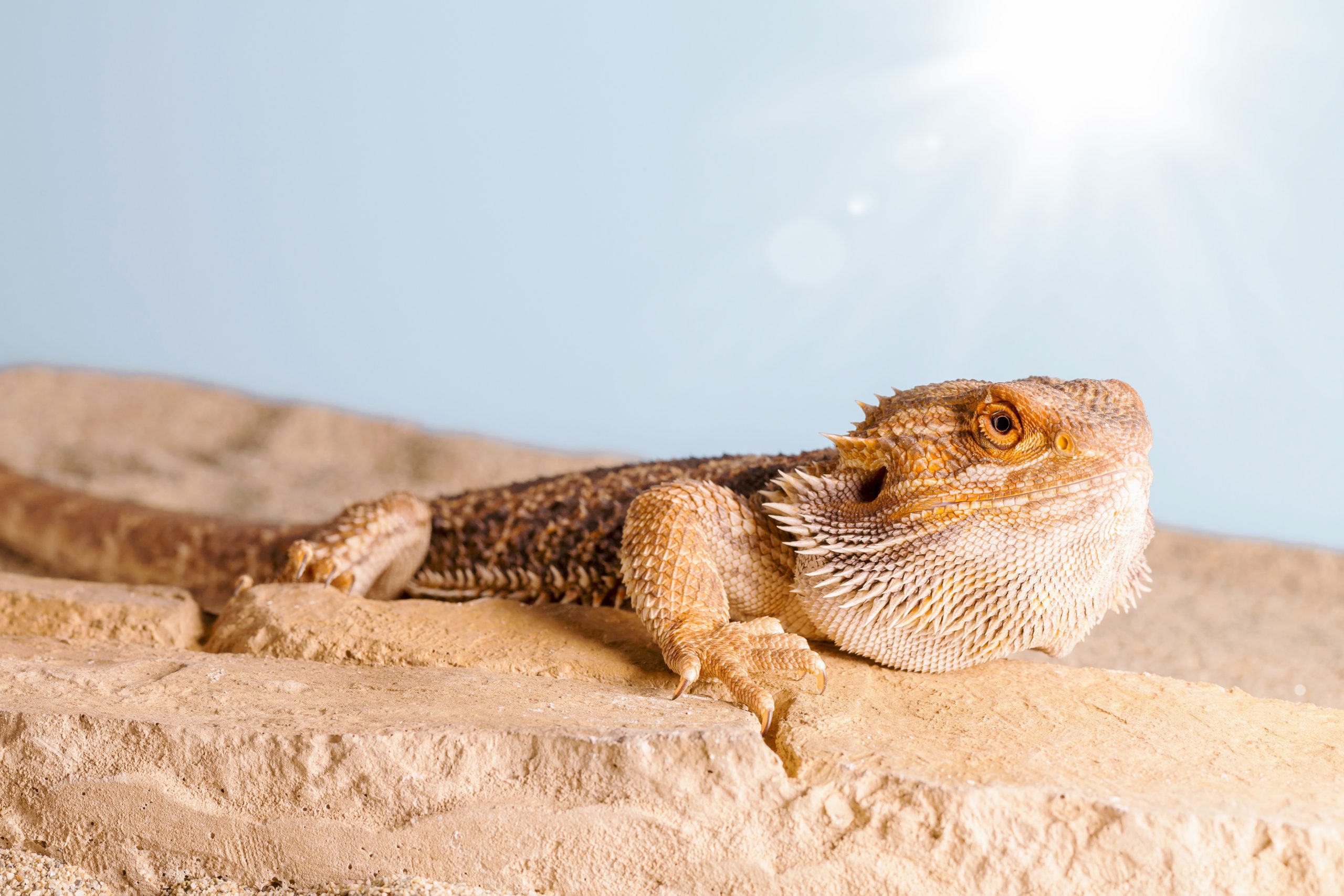Everything you need to know about keeping and caring for Jumping Spiders
Spiders evoke some mixed feelings in most people. Some feel uncomfortable or even scared when they see a spider. But just wait until you try the cute and fun jumping spiders have met! These charming little spiders are absolutely fascinating and fun pets that will really blow your mind.
The growing popularity of jumping spiders as pets is in part due to the positive attention they have received, such as the adorable videos of “Luke the Spider".
These videos have jumping spiders placed in a new light and showing how fun and fascinating they can be as pets.
With their interesting behavior and relatively easy care, these little spiders really can make wonderful pets! And with the right knowledge and care you can easily start your own jumping spiders adventure.

Discover the charm of Jumping Spiders as pets: fascinating, fun and amazing. Thanks to positive attention and cute videos, they have become popular. Start your own jumping spider adventure and experience how fantastic these little spiders can be!
What are Jumping Spiders?
jumping spiders are a family of spiders belonging to the Salticidae family, also known as the jumping arachnids. They are a large and diverse group of spiders found worldwide. jumping spiders are known for their striking appearance, compact size, ranging from a few millimeters to about 2 centimeters.
The appearance of the Jumping Spider
jumping spiders vary in size, but in general they are relatively small, ranging from a few millimeters to a few centimeters. They have a compact physique with eight legs. jumping spiders can have a wide variety of colors and patterns, making them visually appealing.
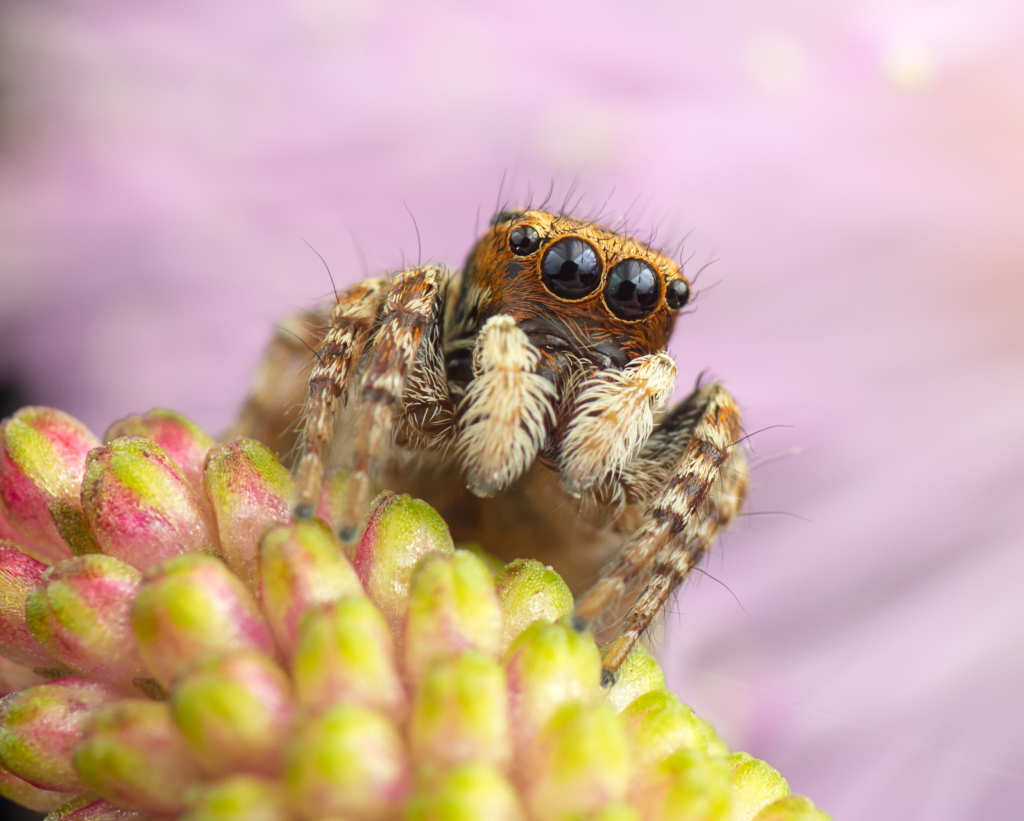
The remarkable eyes of the Jumping Spider
What jumping spiders what really sets them apart is their remarkable eyes. They have eight eyes in total, with the front four eyes being larger and more prominent. These front middle eyes give jumping spiders excellent vision and enable them to perceive depth and detect rapid movement.
Did you know that Jumping Spiders are the only spider species with excellent eyesight? Other spiders generally have less developed vision compared to jumping spiders. Spiders' vision is often adapted to their specific lifestyle and prey capture techniques, and these spiders rely more on other senses, such as touch and vibration.
The incredible jumping ability
jumping spiders are known for their amazing jumping ability. They can bridge distances with great precision and speed. This allows them to stalk and capture prey, as well as escape from potential dangers.
The hunting behavior of jumping spiders
jumping spiders are active hunters. They use their well-developed eyesight and jumping ability to hunt prey. Instead of weaving webs to catch prey, they actively seek out and pounce on their prey with precision and speed.
All in all are jumping spiders fascinating arachnids with their striking appearance, agility and hunting behavior. They have attracted the attention of scientists and exotic pet enthusiasts alike for this, offering a unique perspective on the world of spiders.
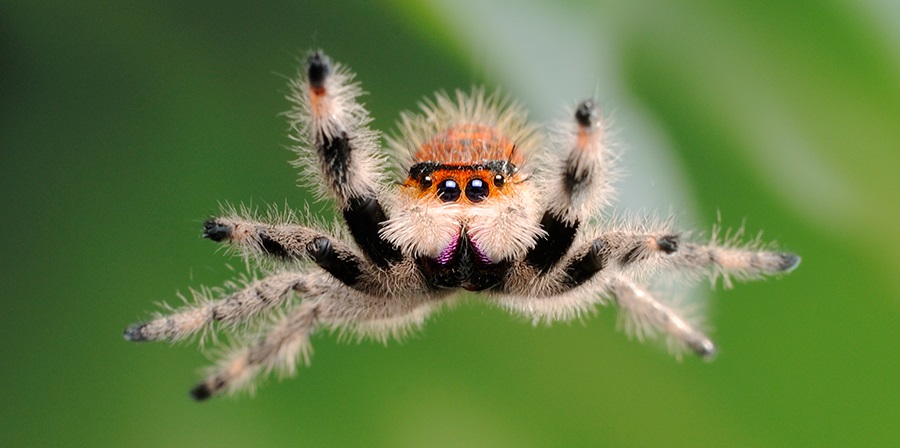
How old do jumping spiders get?
jumping spiders generally have a relatively short lifespan. They can live an average of three years, depending on the species. It is important to take into account that the service life of jumping spiders can vary not only by species, but also by factors such as environmental conditions and care.
Jumping spiders generally have a lifespan of about three years, depending on the species.
With proper care, nutrition en living environment can you extend the life of your jumping spider and ensure they live happy and healthy lives throughout their limited but exciting life as your pet.
Small Miracles with Big Personalities
jumping spiders are known for their extraordinary curiosity and intelligence, which sets them apart from many other spider species. With their astounding intelligence and an awareness of their surroundings, they are jumping spiders exceptionally smart for their size. They possess excellent full color 3D vision, good hearing, and a well-developed sense of touch and smell. This combination enables them to navigate, track down prey and devise complex hunting strategies.
They are sometimes described as eight-legged stuffed animals. Jumping spiders always manage to charm with their fluffy, cute and charming appearance.

They actively interact with their environment and view the world around them with their eyes in a way that is unique to their species. When they look at you, they really see you! they are fully aware of your presence at that moment and judge your size and track your movements.
Their insane vision allows them to visualize where their next prey is and plan multiple routes to get to it. This combination enables them to navigate, track down prey and devise complex hunting strategies.
Jumping spiders surprise with their active communication and awareness of their environment. When they look at you, they really see you. They judge your size while actively tracking your movements.
Creating an Ideal Habitat for Jumping Spiders: Temperature, Humidity and Planting
In loving jumping spiders it is important to ensure a suitable one terrarium. Providing a suitable living environment is essential for your well-being jumping spider. With a well furnished terrarium with the right temperature, humidity and plants you can ensure that you jumping spider feels comfortable and can show his natural behaviour.
The right size terrarium
For young spiders, a terrarium of about 5x5x7 cm is recommended, while adult spiders need a more spacious terrarium of about 20x20x30 cm to be able to move comfortably.
Bigger is not better in the case of jumping spiders. These little spiders grow to a maximum of 2 cm when they are large. This allows them to easily escape from the smallest cracks.
That's why we recommend each terrarium what you want to use for you jumping spider completely check and possibly close small holes and cracks.

Create a comfortable living space for Jumping Spiders with suitable sized terrariums: 5x5x7 cm for young spiders and 20x20x30 cm for adults. Watch for small cracks and holes to prevent escape.
Temperature
As for the temperature, it is ideal to have it terrarium at a temperature of 26 to 28 degrees Celsius. This can be achieved through the use of a heat lamp such as the Lucky Reptile Halogen Sun Mini of 20 watts, always ask if this is the right lamp for your size terrarium. So keep an eye on the temperature with a qualitative. Alternatively, Jumping Spiders can also be kept at room temperature, but in that case they may become slightly less active. Measuring is knowing! thermometer.
We do not recommend using a heat mat under your Jumping Spider Terrarium. This ensures that the bottom of the terrarium dries out quickly.
Humidity
Humidity is an important factor to keep an eye on. An ideal humidity for jumping spiders is between 40% and 70%. It is advisable to measure the humidity using a hygrometerso you can maintain the right levels.

Diversity of Plants
jumping spiders are not only masterful hunters, but they also have a fondness for plants. They love to take their afternoon naps in the lush greenery and enjoy the shelter and relaxation that plants provide.
That is why it is very important to have a well planted terrarium to create where you jumping spider can hide, feel safe and relax in a natural area.
Creating a well planted terrarium for you jumping spider not only offers a visually appealing area, but also promotes the well-being and natural behaviors of your pet. It gives you jumping spider the opportunity to shelter, rest and feel safe in its own green oasis. Make sure you select the right plants, taking into account safety and avoidance of harmful substances, and enjoy the beautiful interplay between jumping spider and plants in this vibrant mini ecosystem.
A suitable living environment is essential for the well-being of jumping spiders. With the right temperature, humidity and plants in the terrarium, you can ensure that your Jumping Spider feels comfortable and can display its natural behavior.
The right bottom
There are estimated to be over 6.000 different known species jumping spiders (family Salticidae) worldwide. This diverse group of arachnids is found in a variety of habitats around the world. Ranging from tropical rainforests to dry deserts, these arachnids thrive in a variety of habitats and have adapted to the diverse environments.
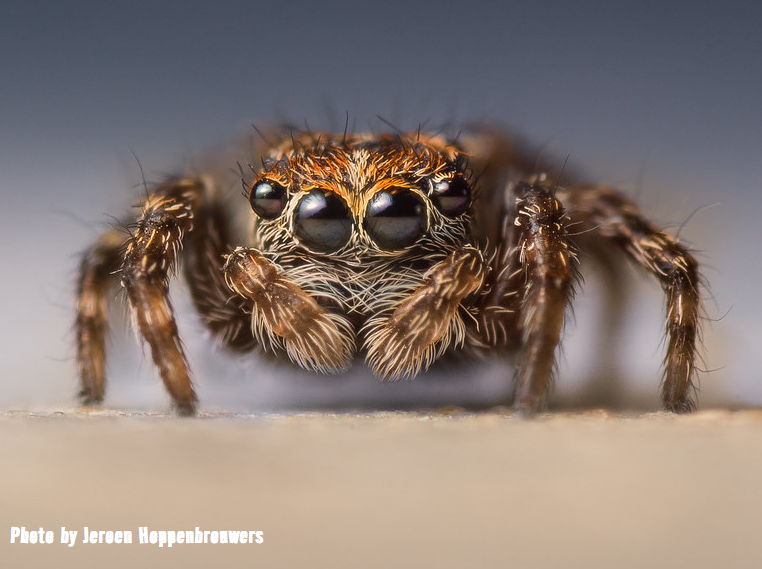
Jumping spiders are a diverse group of arachnids with more than 6.000 known species worldwide. From tropical rainforests to arid deserts, these tiny spiders thrive in a variety of habitats and have adapted to diverse environments.
For a successful terrarium about this jumping spiders a suitable soil is essential. The use of Humus or for Lucky Reptile Jungle Bedding is highly recommended. These soils have excellent moisture-retaining properties, contributing to an ideal humidity in the room terrarium. In addition, they provide a solid foundation on which different plants thrive and feel at home.
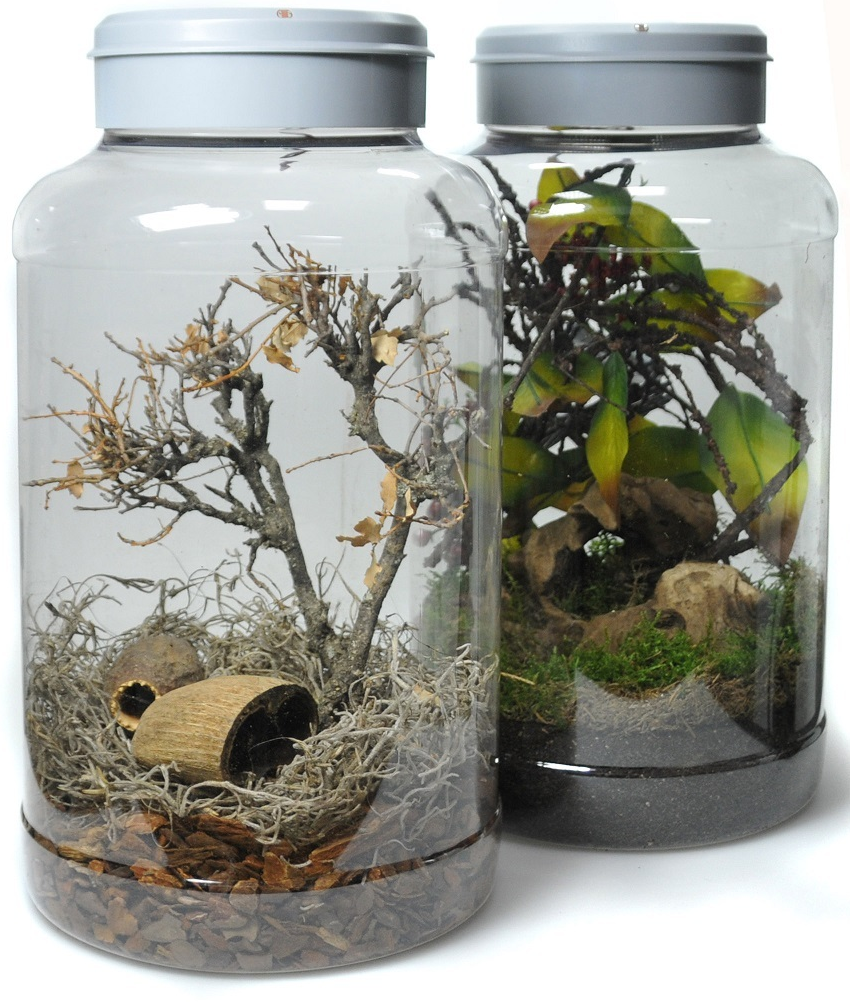
Do you want a unique and eye-catching home for your Springspin? Then it is Lucky Reptile Insect Terrarium the perfect choice! This special terrarium is equipped with both day and night light, making it a beautiful sight, both during the day and at night. Thanks to the sensitive light sensor, the terrarium is illuminated blue at night, which creates an atmospheric effect.
Food for Jumping Spiders
Careful attention to the nutrition and hydration of jumping spiders helps maintain their health and well-being. Providing a varied diet of suitable insects and access to water is essential to ensure these fascinating arachnids thrive in captivity.
The diet of jumping spiders is filled with a variety of insects depending on their age and size. Young jumping spiders feed on the smallest size fruit flies en micro crickets up to size 2. As they mature, they can eat prey up to the size of their own body. These are then curl flies, fruit flies, houseflies and crickets from size 2.
A varied diet of appropriately sized insects and regular hydration are essential to the well-being of Jumping Spiders.
To meet their nutritional needs, it is recommended to jumping spiders about 3 to 4 insects per week, which equates to feeding every other day. It is important to remember that if a jumping spider does not eat its prey, such as a cricket, it is recommended to remove the uneaten prey from the spider's habitat. This is because a jumping spider can be mistakenly mistaken for by the cricket while molting or sleeping food, with potentially fatal consequences.
Meet Jumping Spiders' nutritional needs by feeding them 3 to 4 insects per week. Remove uneaten prey to avoid potential risks.
In addition to having food jumping spiders also need regular watering. It is best to offer a drop of water every few days. This can be achieved by ensuring that there are drops of water in the enclosure, such as on the plants or the windows.
A fine mist can be created using the Back Zoo Nature Extreme Mist Maker, as a result of which jumping spiders be able to drink easily and stay hydrated.

Can You Keep Jumping Spiders Together?
No, it is generally not recommended to jumping spiders to keep together. jumping spiders are solitary animals and tend to be territorial. Housing together jumping spiders can lead to aggression and cannibalism, where one spider sees another as prey and attacks it.
Jumping spiders are solitary animals and should be housed individually to avoid conflict and injury.
This can result in serious injury or death to one of the spiders. So it is the safest and most convenient to jumping spiders individually housed in separate terrariums, where they can thrive without the risk of conflict with other spiders.



